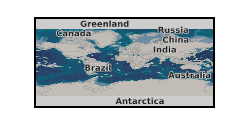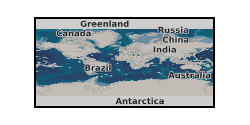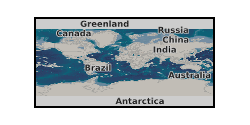Plymouth Marine Laboratory
Type of resources
Topics
Keywords
Contact for the resource
Provided by
Years
Formats
Representation types
Update frequencies
Resolution
-

The potential for leakage of CO2 from a storage reservoir into the overlying marine sediments and into the water column and the impacts on benthic ecosystems are major challenges associated with Carbon Capture and Storage (CCS) in subseafloor reservoirs. A field-scale controlled CO2 release experiment was conducted in shallow, unconsolidated marine sediments. Changes were monitored of the chemical composition of the sediments and overlying water column before, during and up to 1 year after the 37-day long CO2 release from May 2012 to May 2013 in Ardmucknish Bay. Meiofaunal samples were collected and meiofauna higher taxa and the nematodes species (where possible) were identified by Plymouth Marine Laboratory. This dataset was collected under the program QICS (Quantifying and monitoring environmental impacts of geological carbon storage) which was funded by the Natural Environment Research Council (NERC), with support from the Scottish Government. The results are contained in an Excel file. QICS project website: www.bgs.ac.uk/qics/home.html. This data is currently under embargo until publication of the dataset in research article (estimated end of 2015).
-

The response of the benthic microbial community to a controlled sub-seabed CO2 leak was assessed using quantitative PCR measurements of benthic bacterial, archaeal and cyanobacteria/chloroplast 16S rRNA genes. Similarly, the impact of CO2 release on the abundance of benthic bacterial and archaeal ammonia amoA genes and transcripts, and also to the abundance of nitrite oxidizer (nirS) and anammox hydrazine oxidoreductase (hzo) genes and transcripts. Samples were taken from four zones (epicentre (zone 1); 25m distant (zone 2), 75m distant (zone 3) and 450m distant (zone 4)) during 6 time points (7 days before CO2 exposure, after 14 and 36 days of CO2 release, and 6, 20 and 90 days after the CO2 release had ended). Changes to the active community of microphytobenthos and bacteria were also assessed before, during and after CO2 release using Denaturing Gradient Gel Electrophoresis of cyanobacteria/chloroplast 16S rRNA. Changes to the composition of the active bacterial community was assessed first using Terminal Restriction Fragment Length Polymorphism (T-RFLP) of bacterial 16S rRNA. In depth comparisons of possible changes to the active bacterial community at zone 1 and 4 before, during and immediately after the CO2 release was performed using 16S rRNA 454 pyrosequencing. This dataset was created by Plymouth Marine Laboratory (PML) under the program QICS (Quantifying and monitoring environmental impacts of geological carbon storage) which was funded by the Natural Environment Research Council (NERC), with support from the Scottish Government. The results are contained in three text files. QICS project website: www.bgs.ac.uk/qics/home.html. Tait et al. (2015) Rapid response of the active microbial community to CO2 exposure from a controlled sub-seabed CO2 leak in Ardmucknish Bay (Oban, Scotland). IJGGC DOI: 10.1016/ijggc.2014.11.021. Watanabe et al. (2015) Ammonia oxidation activity of microorganisms in surface sediment to a controlled sub-seabed release of CO2. IJGGC DOI: 10.1016/j.ijggc.2014.11.013.
-
The data set comprises measurement of physical and biological oceanographic parameters from the Western English Channel, initially collected as part of the Plankton Monitoring Programme at Station L4 from 1988 onwards. L4 is one of a series of hydrographic stations in the Western English Channel which have also been the basis of a series of hydrographic surveys carried out during the 20th Century by scientists at the Marine Biological Association in Plymouth. In May 2002 sampling expanded to include Station E1, approximately 25 nautical miles south-west of Plymouth. Plankton Monitoring began through the work of the Plymouth Marine Laboratory (PML) Zooplankton Group. Other stations include Rame head, Jennycliff, Plmouth Deep and Cawsand. A long-term time-series of weekly observations has been established by exploiting the activities of small boats (Sepia, Squilla and Plymouth Quest) in an opportunistic way as by-product of their other sampling activities, for example the collection of live plankton, sea-water, trawling for fish and squid. Initially no formal research programme or long-term funding for the Plankton Monitoring existed but the series was included in NERC Oceans 2025 funding as a Sustained Observatory and continues to be funded under NERC National Capability. Funding has been provided over different time periods under various names but the programme is commonly referred to as the Western Channel Observatory (WCO), with additional funding allowing additional data collection to take place, taking advantage of the core measurements. Although every attempt has been made to standardise methodology and achieve data consistency it is important to recognize that the varied personnel and research objectives that have contributed to this dataset may impact on the nature of the data set. The core datasets are made available through the westernchannelobservatory.org website. Data are also submitted to BODC where it is archived and published with a DOI at finer granules. At BODC further meta(data) checks take place and metadata are enriched and served through BODC systems with PML originators informed of any changes to data.
-

The response of the benthic microbial community to a controlled sub-seabed CO2 leak was assessed using quantitative PCR measurements of benthic bacterial, archaeal and cyanobacteria/chloroplast 16S rRNA genes. Samples were taken from four zones (epicentre; 25 m distant, 75 m distant and 450 m distant) during 6 time points (7 days before CO2 exposure, after 14 and 36 days of CO2 release, and 6, 20 and 90 days after the CO2 release had ended). Changes to the active community of microphytobenthos and bacteria were also assessed before, during and after CO2 release. Increases in the abundance of microbial 16S rRNA were detected after 14 days of CO2 release and at a distance of 25 m from the epicentre. CO2 related changes to the relative abundance of both major and minor bacterial taxa were detected: most notably an increase in the relative abundance of the Planctomycetacia after 14 days of CO2 release. Also evident was a decrease in the abundance of microbial 16S rRNA genes at the leak epicentre during the initial recovery phase: this coincided with the highest measurements of DIC within the sediment, but may be related to the release of potentially toxic metals at this time point. This is a publication in QICS Special Issue - International Journal of Greenhouse Gas Control, Karen Tait et. al. Doi:10.1016/j.ijggc.2014.11.021.
-

A sub-seabed release of carbon dioxide (CO2) was conducted to assess the potential impacts of leakage from sub-seabed geological CO2 Capture and Storage CCS) on benthic macrofauna. CO2 gas was released 12 m below the seabed for 37 days, causing significant disruption to sediment carbonate chemistry. Regular macrofauna samples were collected from within the area of active CO2 leakage (Zone 1) and in three additional reference areas, 25 m, 75 m and 450 m from the centre of the leakage (Zones 2, 3 and 4 respectively). Macrofaunal community structure changed significantly in all zones during the study period. However, only the changes in Zone 1 were driven by the CO2 leakage with the changes in reference zones appearing to reflect natural seasonal succession and stochastic weather events. The impacts in Zone 1 occurred rapidly (within a few days), increased in severity through the duration of the leak, and continued to worsen after the leak had stopped. Considerable macrofaunal recovery was seen 18 days after the CO2 gas injection had stopped. In summary, small short-term CCS leakage events are likely to cause highly localised impacts on macrofaunal communities and there is the potential for rapid recovery to occur, depending on the characteristics of the communities and habitats impacted. This is a publication in QICS Special Issue - International Journal of Greenhouse Gas Control, Stephen Widdicombe et. al. Doi:10.1016/j.ijggc.2015.01.003.
-

Available methods for measuring the impact of ocean acidification (OA) and leakage from carbon capture and storage (CCS) on marine sedimentary pH profiles are unsuitable for replicated experimental setups. To overcome this issue, a novel optical sensor application is presented, using off-the-shelf optode technology (MOPP). The application is validated using microprofiling, during a CCS leakage experiment, where the impact and recovery from a high CO2 plume was investigated in two types of natural marine sediment. MOPP offered user-friendliness, speed of data acquisition, robustness to sediment type, and large sediment depth range. This ensemble of characteristics overcomes many of the challenges found with other pH measuring methods, in OA and CCS research. The impact varied greatly between sediment types, depending on baseline pH variability and sediment permeability. Sedimentary pH profile recovery was quick, with profiles close to control conditions 24 h after the cessation of the leak. However, variability of pH within the finer sediment was still apparent 4 days into the recovery phase. Habitat characteristics need therefore to be considered, to truly disentangle high CO2 perturbation impacts on benthic systems. Impacts on natural communities depend not only on the pH gradient caused by perturbation, but also on other processes that outlive the perturbation, adding complexity to recovery. This is a publication in QICS Special Issue - International Journal of Greenhouse Gas Control, Ana M. Queirós et. al. Doi:10.1016/j.ijggc.2014.10.004.
-
Results of a survey undertaken in 2018 involving a range of open and closed questions intended to elicit local residents’ values they attach to the importance of coastal attributes and their perceptions of various tidal and wave energy development characteristics. Three case study sites were selected: Weston-super-Mare, Minehead, and the Taw-Torridge Estuary, South-West UK. Full details about this dataset can be found at https://doi.org/10.5285/e5190fd0-2995-42aa-aca0-80714abde768
-
This dataset comprises 50 hydrographic data profiles, collected by a conductivity-temperature-depth (CTD) sensor package, during April - May 1990 from stations covering the southern North Sea (south of 56N). A complete list of all data parameters are described by the SeaDataNet Parameter Discovery Vocabulary (PDV) keywords assigned in this metadata record. The data were collected by the Plymouth Marine Laboratory as part of the North Sea Project Blooms/Chemistry Process Study.
-
This dataset comprises 50 hydrographic data profiles, collected by a conductivity-temperature-depth (CTD) sensor package, in July 1990 from stations covering the southern North Sea (south of 56N). A complete list of all data parameters are described by the SeaDataNet Parameter Discovery Vocabulary (PDV) keywords assigned in this metadata record. The data were collected by the Plymouth Marine Laboratory as part of the North Sea Project Resuspension Process Study.
-
This dataset comprises 38 hydrographic data profiles, collected by a conductivity-temperature-depth (CTD) sensor package, during September – October 1999 along the Atlantic Meridional Transect (AMT) from the UK to Montevideo, Uruguay. A complete list of all data parameters are described by the SeaDataNet Parameter Discovery Vocabulary (PDV) keywords assigned in this metadata record. The data were collected by the Plymouth Marine Laboratory as part of the Atlantic Meridional Transect (Phase 1) programme.
 NERC Data Catalogue Service
NERC Data Catalogue Service